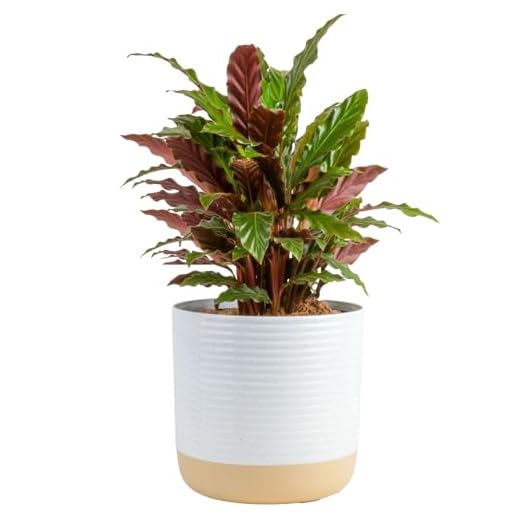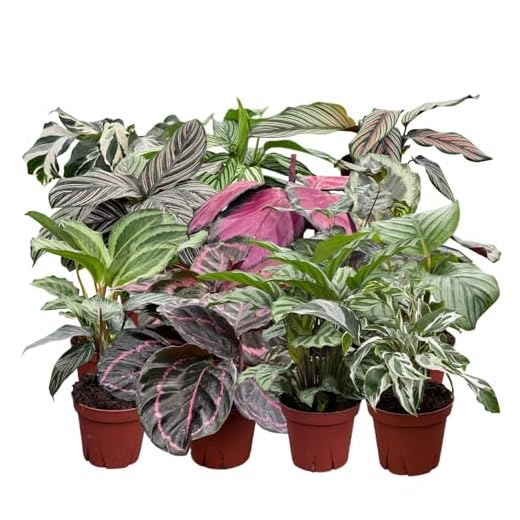



Yes, these leafy companions are safe for us furry pals. Unlike many other greenery options, they won’t cause harm if we decide to nibble on their leaves.
As an 8-year-old Scottish Fold, I have explored my human’s home and have come across various types of houseplants. The vibrant patterns and colors of these beauties caught my attention, but I’m glad to report that they are non-harmful for curious kitties like me.
However, while these plants won’t pose a threat, it’s always wise to monitor our playtime. Even safe greenery can cause mild stomach upset if consumed in large quantities. A little nibble here and there should be perfectly fine, but if you notice anything unusual, a quick visit to the vet is always a good idea.
So, if your home is graced with these lovely greenery, rest assured, you can enjoy them without worrying about our health!
Are Calathea Plants Safe for My Feline Friends?
These leafy beauties are not harmful to my furry companions. They won’t cause any distress or health issues if they happen to take a nibble. Their non-toxic nature makes them a safe choice for homes with curious pets. However, it’s wise to keep an eye on my playful pals, as they might be intrigued by the vibrant foliage.
While munching on these greens won’t lead to serious problems, excessive chewing can still upset a kitty’s stomach. If I see any signs of discomfort or unusual behavior, I’ll consult my human to ensure everything is alright. It’s always best to monitor my feline family’s interactions with any greenery.
Choosing safe greenery can enhance our living space without worrying about potential hazards. So, if you’re looking to add some flair to your home while keeping it pet-friendly, these plants fit the bill perfectly!
Understanding Plant Characteristics
These beauties are known for their stunning foliage, featuring intricate patterns and rich hues. They thrive in humid environments, making them ideal for homes with high moisture levels. The leaves undulate gracefully in response to light, creating a captivating display.
It’s crucial to maintain consistent watering. The soil should be kept moist but not soggy. Overwatering can lead to root rot, while underwatering may cause leaf curling. A well-draining potting mix helps provide the right balance.
Humidity levels play a significant role in their health. Regular misting or a pebble tray with water can help mimic their natural habitat. If your home is particularly dry, consider using a humidifier to maintain optimal conditions.
These greens are sensitive to direct sunlight. Ideally, they prefer bright, indirect light. Too much sun can scorch their delicate leaves, causing unsightly brown patches.
When caring for feline friends, consider their interactions with these greens. While they are non-harmful, providing a hairball remedy for cats may be beneficial to keep your kitty comfortable around houseplants.
Occasionally, pests like spider mites and aphids may invade. Regular inspections and gentle cleaning can help keep these nuisances at bay. In case of an infestation, natural insecticidal soap can be an effective solution.
For pet owners, ensuring a safe environment is key. While these greens are safe, monitoring your furry companion’s behavior around them is wise. If your dog ventures too close, consider using the best 6 month flea collars for dogs to keep them secure from wandering into any trouble.
Identifying Common Calathea Varieties
When exploring the world of these leafy companions, distinct types caught my attention. The first is the “Prayer Plant,” known for its unique leaf movements that mimic prayer hands. This variety features striking patterns, with deep greens and purples, making it a visual delight.
Next, I found the “Rattlesnake Plant.” Its elongated leaves showcase wavy patterns resembling a snake’s skin, adorned with dark green and light green stripes. This one adds a playful touch to any space.
The “Zebra Plant” is another favorite, characterized by its bold white stripes against a rich green backdrop. Its robust leaves create an eye-catching contrast that stands out in any arrangement.
I also came across the “Ctenanthe” variety, commonly known as the “Never Never Plant.” This one’s leaves are slightly broader with a glossy finish, and it reveals beautiful patterns that change under different lighting conditions.
Lastly, the “Mosaic Plant” intrigued me with its intricate leaf designs, resembling a patchwork quilt. The vibrant colors make it a perfect conversation starter in any home.
These varieties not only beautify a space but also provide a range of textures and patterns that bring joy to daily life. Each type has its own charm, making them delightful companions for any enthusiast.
Assessing Toxicity Levels of Calathea Plants
These green companions are generally considered safe for my furry friends. Ingesting any part of these foliage companions typically does not lead to severe health issues. However, it’s wise to keep an eye on their consumption.
Here’s what to monitor:
- Digestive Upset: If a curious feline nibbles on the leaves, they might experience mild stomach discomfort. Look out for symptoms like vomiting or diarrhea.
- Allergic Reactions: Some pets may have sensitivities. Watch for any unusual behaviors or rash-like symptoms after contact.
- Chewing Habits: Regular chewers can develop a habit. Redirecting their attention to cat grass or other safe options can help.
While these plants don’t pose significant risks, it’s always advisable to consult a veterinarian for personalized guidance. Keeping the environment safe for both the greens and my feline pals ensures a happy home.
Symptoms of Calathea Plant Toxicity in Cats
When I munch on the leaves of certain house greenery, a few signs may appear. If I start to drool excessively, it might indicate irritation in my mouth or throat. Watch for vomiting; it’s a clear signal that something isn’t right in my tummy. If I seem to be pawing at my mouth or if I refuse to eat, those can be red flags too.
Another thing to look out for is lethargy. If I’m less playful or just lying around more than usual, it’s a cause for concern. Sometimes, I might even show signs of discomfort, like whining or hiding. If these symptoms pop up after nibbling on any foliage, it’s wise to seek help from a vet right away.
Always keep an eye on me and my furry pals–our health is the priority! If you suspect that I’ve had a run-in with harmful greenery, don’t hesitate to act quickly.
Safe Alternatives for Cat Owners
If you’re looking for safe greenery for your home, consider spider plants. They are non-harmful and thrive in various conditions, making them a popular choice among pet owners. Another option is the Boston fern, known for its air-purifying qualities and resilience.
Ponytail palms also make a great addition to your collection. Their unique appearance adds character, and they are completely safe for furry friends. If you prefer flowering options, African violets are both beautiful and non-dangerous for curious paws.
For those who enjoy herbs, basil and catnip are excellent choices. Not only are they harmless, but they can also provide stimulation and enjoyment for your feline companion. Finally, consider peace lilies as an alternative; they offer stunning flowers while being safe for your home environment.
Creating a Cat-Friendly Indoor Garden
To keep my space safe and enjoyable, I’ve curated a selection of non-harmful greenery that thrives indoors. Here are my top recommendations for creating a cat-friendly indoor haven:
- Spider Plant: This hardy green companion is safe and even helps purify the air. It’s easy to maintain and doesn’t mind a little neglect.
- Ponytail Palm: With its unique appearance, this succulent adds charm without posing any risk. It loves bright light but can adapt to lower conditions.
- Bamboo Palm: This tropical beauty not only looks great but also filters indoor air. It’s a refreshing addition to my environment.
- Boston Fern: This lush fern thrives in humidity, making it perfect for bathrooms or kitchen spaces. It’s a soft and safe choice for curious paws.
- Prayer Plant: Its stunning leaf patterns are mesmerizing. Plus, it’s completely safe for my feline friends, providing a touch of beauty without concern.
In addition to choosing suitable varieties, consider the following tips for an ideal setup:
- Placement: Position greenery out of reach to prevent any playful nibbling, while still allowing me to enjoy the view.
- Water Management: Ensure proper drainage to avoid mold and rot, which can harm both the plants and the air quality.
- Regular Maintenance: Keep an eye on soil moisture and remove any dead leaves. A tidy space is more enjoyable for everyone.
- Interactive Features: Incorporate cat-friendly elements like scratching posts or climbing shelves near plants. This keeps me entertained while protecting the green friends.
By selecting safe greenery and following these simple strategies, I can enjoy a beautiful indoor environment without worries. Happy planting!
First Aid Steps for Felines Exposed to the Plant
If I ever munch on a leaf from that leafy friend, here’s what you should do immediately:
1. Remove the Plant: Take away the offending greenery from my reach to prevent further nibbling.
2. Check for Symptoms: Look for signs like drooling, vomiting, or any unusual behavior. Note the symptoms for the vet.
3. Rinse the Mouth: If you see me chewing, flush my mouth with water to remove any residue. Use a syringe or your hand gently.
4. Monitor My Behavior: Keep an eye on me for a few hours. If I act strangely or show distress, it’s time to consult a vet.
5. Contact a Veterinarian: If symptoms appear or worsen, call the vet right away. Provide details about the incident and any signs you’ve observed.
| Symptom | Action |
|---|---|
| Drooling | Rinse mouth and observe |
| Vomiting | Contact vet |
| Diarrhea | Monitor and inform vet |
| Lethargy | Immediate vet visit |
By following these steps, you can help ensure I stay safe and healthy. Always better to be cautious, right?









